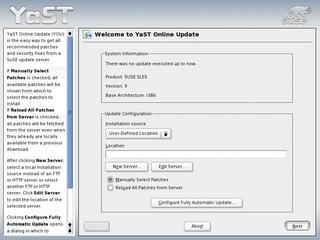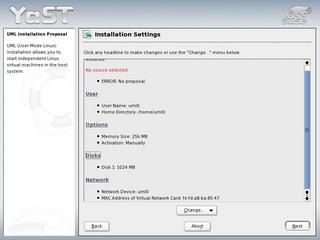A look at Novell's Suse Linux Enterprise Server 9
A New Suse Server
Larkin Cunningham
A look at Novell's Suse Linux Enterprise Server 9A New Suse ServerLarkin Cunningham |

|
Novell recently became the first major corporate Linux vendor to release a kernel 2.6 Linux distribution for the enterprise market. By integrating Suse Linux Enterprise Server (SLES9) [1] into Novell's family of complementary networking software products, such as Netware and Open Enterprise Server (OES) [2], Novell hopes to persuade Suse customers to think seriously about extending their commitment to Novell beyond just servers and desktops.
In this article, I'll show you what's inside Suse Linux Enterprise Server 9, and what the 2.6 kernel will mean for the new generation of enterprise servers.
SLES9 comes on 6 CD-ROMs. There are 5 CD-ROMs for Suse CORE 9 and 1 for SLES9 specific files. Suse CORE 9 is a set of common packages for Suse's new corporate Linux distributions. We might expect to see OpenExchange 5.0 based on SUSE CORE 9 at some point in the future.
For 10 years now, YaST (Yet another Setup Tool) has provided excellent system management features for Suse operating systems. YaST was always a proprietary tool of Suse's until the acquisition by Novell. Novell decided to release YaST under a general public license (GPL). This means that independent software vendors (ISVs) can develop modules for YaST to integrate configuration of their products into Suse's central YaST control center.
YaST is used to install the operating system from scratch and is also used to upgrade from previous versions. Installation of SLES9 with YaST is very similar to the installation of SLES8 with YaST (see Figure 1). Almost all of the options are the same, except for the optional configuration of Lightweight Directory Access Protocol (LDAP), which can be used for user authentication in place of the usual /etc/passwd method of traditional Unix.
All the YaST system configuration modules from SLES8 are included in SLES9, many with significant improvements, such as Samba 3 configuration (see Figure 2). YaST also comes with some new modules, including Email Server configuration, Heartbeat configuration for high availability, User Mode Linux configuration, and several others. User Mode Linux (UML) allows a system administrator to create virtual Linux instances that have their own memory and disk space. This feature is ideal for creating test environments and for hosting independent applications on the same server.
One of the shortcomings of YaST has been the inability to manage patches and software packages across multiple servers using a centralized management tool. Red Hat addressed this somewhat with Red Hat Network (RHN), which allows you to register your servers and to automate the application of errata and product updates. SLES9 does not restrict you to only using YaST's Online Update (YOU) (see Figure 3). Now you can use other Novell management tools such as ZENworks and Ximian Red Carpet to centrally manage errata and updates for all your servers.
Traditionally, Linux distributions have allowed a huge package selection. Even SLES8 and Red Hat Enterprise Linux 3 (RHEL3) allowed you to select all the packages you would need for a desktop PC. However, this approach leads to unnecessary packages being installed and ultimately leads to increased patch management for applications that are not being used. It makes sense for a Linux distribution aimed squarely at the enterprise server market to include packages suitable only for servers. You will not be given an option to install office software such as OpenOffice.org with SLES9. This contrasts with the first beta release of RHEL4, which contains twice the volume of package options.
As is typical with an enterprise Linux distribution, package versions are tightly controlled and are maintained consistently with errata and patches. Often features introduced in later versions of the software are backported by the Linux distributor, Novell in this case. This approach to package distribution ensures a level of consistency and compatibility with downloaded patches. (With SLES8, there were many features of the 2.6 kernel that were backported to SLES8's 2.4 kernel before they were introduced into later versions of the standard or vanilla 2.4 kernel.)

Many of the new features and enhancements in SLES9 have a lot to do with the use of kernel 2.6. In terms of scalability, SLES9 now has no limit on the number of CPUs you can use. SLES9 has been tested with over 128 CPUs, so if raw computing power is what you need, SLES9 can certainly pack a punch. SLES9 systems can also support more users, processes, and open files than previous versions.
Device support is greatly enhanced in SLES9. SLES9 systems can handle 4,095 device types and over a million subdevices per device type. This will mean even larger storage arrays, for example. A SLES9 server can manage more devices, including controlling up to 32,000 SCSI disks. Support for USB 2.0 and Firewire is included, as is support for Serial-ATA .
I installed SLES9 onto an IBM T20 laptop with a Lucent winmodem and an SMC wireless PCMCIA network card. SLES9 recognized all the hardware immediately, giving me confidence that SLES9 is likely to recognize a wide array of devices, mostly thanks to improvements in hardware detection with kernel 2.6.

| Suse Linux Enterprise Server 9 |
|
Pricing x86 and AMD64 and Intel EM64T Architectures
Itanium and IBM Power Architectures
IBM zSeries and IBM S/390 Architectures
|
One of the major new features that kernel 2.6 brought to Linux was Non-Uniform Memory Access (NUMA) [3]. Traditional multi-processing support, symmetric multi-processing (SMP), allows each processor equal access to memory and I/O. The contention on the processor bus can become a bottleneck and adversely affect optimal performance. NUMA, however, gives pro- cessors, or groups of processors (called nodes), access to local memory using a dedicated memory bus. By designing applications to concentrate on local memory and minimizing inter-node communication, application vendors can achieve increased scalability and enhanced system performance using NUMA.
You might ask if there are any applications that have been developed to use NUMA, and the answer is that there are not that many. However, Oracle and IBM are developing support for NUMA in their flagship database products Oracle and DB2. Already benchmarks for these databases on SLES9 are impressive, and the use of NUMA can only increase those benchmarks further.
One of the major concerns of any business is continuity. For some businesses, having a critical service unavailable for a number of hours can cost millions of Euros in lost production time. Novell have implemented their own version of a heartbeat high availability system for clustering and failover. Heartbeat monitoring refers to the ability of one node to detect that another node is down when it fails to detect the missing node's "heartbeat." According to Novell, SLES9 can be tuned to detect a missing heartbeat in less than one second. This early detection allows for sub-second failover in the most critical of environments. Failed nodes can be re-introduced automatically or manually.
One other interesting feature related to high availability and fault tolerance is the Distributed Replicated Block Device (DRBD.) DRBD refers to RAID level 1 distributed over a network. This feature supports multiple disks on multiple devices mirrored over a network. In the unlikely event that a localized fire were to destroy one room full of servers, another room full of servers could have mirrored disks with live, up-to-the-second data.


| Notable packages in SLES9 |
|
|
So, with all the new features in SLES9, will corporations be rushing out to buy it? There will be some early adopters of SLES9 who are buying it because it is an excellent server solution for general applications, such as email servers or PHP/MySQL servers. But it will take time for important certifications to come from the major hardware and software vendors. Suse has strong ties with IBM and you can expect IBM to be shipping SLES9-certified hardware in the near future. Expect HP and others to follow quickly also. Oracle, who are developing their own Linux software using SLES, can be sure to certify their key software for SLES9 soon, as will IBM with their DB2 database.
Existing users of SLES8 may have no compelling reason to upgrade for now because SLES8 should be supported for at least another three years. Some existing users may decide to upgrade anyway to take advantage of Novell's vast array of networking and system management tools.
With the first service pack for SLES9, which includes Novell's support for Open Enterprise Server, scheduled for release in February 2005, and software and hardware certifications also coming on stream soon, I would expect a significant demand for SLES9 next year. Novell may have timed the release of this product to perfection. It is possible that the first service pack for SLES9 could appear before Red Hat even gets RHEL4 released.
Suse Linux Enterprise Server 9, with its 2.6 kernel and other important enhancements, is another indication that the acquisition of Suse by Novell has breathed new life into both Novell and Suse. Novell's name and marketing power can only help increase the market share of Suse Linux, and Suse could become a real threat to Red Hat's position as the leading corporate Linux distribution, not to mention Microsoft's position in the overall server market. All this can only encourage other vendors to come up with even better offerings. As long as Novell continues its support of open source technology and continues to bring new innovations to Suse, the Linux world can only benefit.
| Info |
|
[1] Suse Linux Enterprise Server 9 http://www.novell.com/products/linuxenterpriseserver/ [2] Novell Open Enterprise Server http://www.novell.com/products/openenterpriseserver/ [3] Non-Uniform Memory Access (NUMA) FAQ: http://lse.sourceforge.net/numa/faq/index.html |
| The Author |
|
Larkin Cunningham is one of the founders of DB Alliance, an Irish company specializing in Linux and Open Source solutions. He enjoys exploring the latest open source applications to see how they can reduce costs and improve efficiency. |